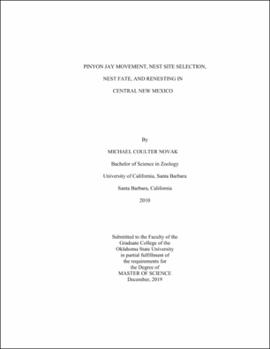| dc.contributor.advisor | Smith, Loren M. | |
| dc.contributor.author | Novak, Michael Coulter | |
| dc.date.accessioned | 2020-06-29T17:39:14Z | |
| dc.date.available | 2020-06-29T17:39:14Z | |
| dc.date.issued | 2019-12 | |
| dc.identifier.uri | https://hdl.handle.net/11244/324902 | |
| dc.description.abstract | Pinyon jays (Gymnorhinus cyanocephalus) are an avian species of conservation concern in the southwest U.S. Due to habitat elimination and degradation, pinyon jay numbers have decreased approximately 3.5% per year since 1960. Pinyon jay reproductive rates are low, making it difficult for populations to recover. While numerous studies on pinyon jays have been conducted in ponderosa pine (Pinus ponderosa) forest, research has only recently taken place in pinyon pine (Pinus edulis) and juniper (Juniperus monophylla) woodland. Therefore, my objectives were to investigate pinyon jay flock movement, nest site selection, nest fate, and renesting in pinyon-juniper habitat. I trapped and affixed VHF radio transmitters to pinyon jays on Kirtland Air Force Base (KAFB) in central New Mexico from December to April in 2017 and 2018. I used radio telemetry to compare seasonal flock movements and core activity areas as well as find pinyon jay nesting colonies. Habitat surveys that recorded vegetation type, species, size, and foliage cover were performed at every nest site (n=42) as well as a similar number of randomized locations (n=41) within pinyon-juniper habitat. Movement data was analyzed using kernel density estimates to identify core activity areas. Nest site selection habitat data were compared to habitat at random sites using generalized linear models (GLMs) evaluated with Akaike's Information Criterion corrected for small sample size (AICc). Variables that affected nest fate were used in GLMs with a logistic exposure function, then evaluated using AICc. | |
| dc.description.abstract | Results suggest that there were 2 flocks on KAFB and spatial analyses should be conducted for each flock to determine accurate home ranges. Pinyon jays selected nest sites with fewer dead juniper trees and nest trees that were larger than surrounding trees in the same survey plot. Nest fate models did not perform better than the null model. Pinyon jays in this study did not renest as much as in ponderosa pine forest, perhaps due to lack of food and water availability. Furthermore, pinyon jays did not nest in satellite colonies as in other studies. Management recommendations are to remove smaller, less healthy trees in pinyon jay habitat when tree thinning occurs and leaving larger, healthier trees. | |
| dc.format | application/pdf | |
| dc.language | en_US | |
| dc.rights | Copyright is held by the author who has granted the Oklahoma State University Library the non-exclusive right to share this material in its institutional repository. Contact Digital Library Services at lib-dls@okstate.edu or 405-744-9161 for the permission policy on the use, reproduction or distribution of this material. | |
| dc.title | Pinyon jay movement, nest site selection, nest fate, and renesting in central New Mexico | |
| dc.contributor.committeeMember | McMurry, Scott T. | |
| dc.contributor.committeeMember | Davis, Craig A. | |
| osu.filename | Novak_okstate_0664M_16498.pdf | |
| osu.accesstype | Open Access | |
| dc.type.genre | Thesis | |
| dc.type.material | Text | |
| dc.subject.keywords | avian ecology | |
| dc.subject.keywords | birds | |
| dc.subject.keywords | pinyon jay | |
| dc.subject.keywords | pinyon-juniper woodlands | |
| dc.subject.keywords | southwestern ecology | |
| thesis.degree.discipline | Integrative Biology | |
| thesis.degree.grantor | Oklahoma State University | |
